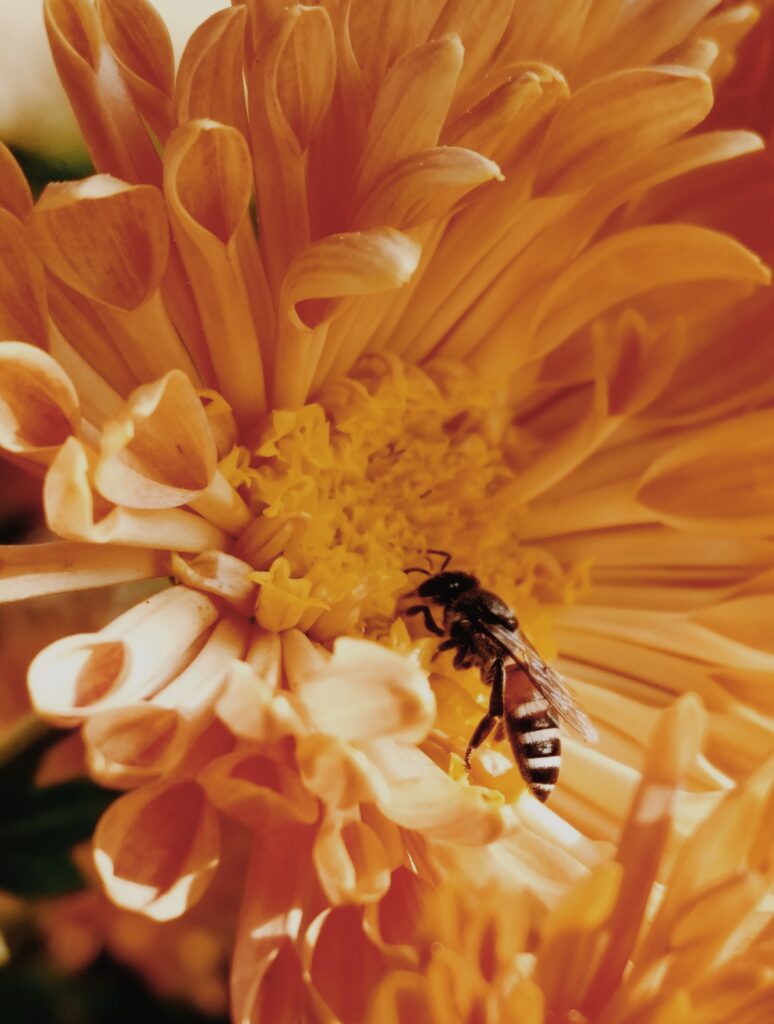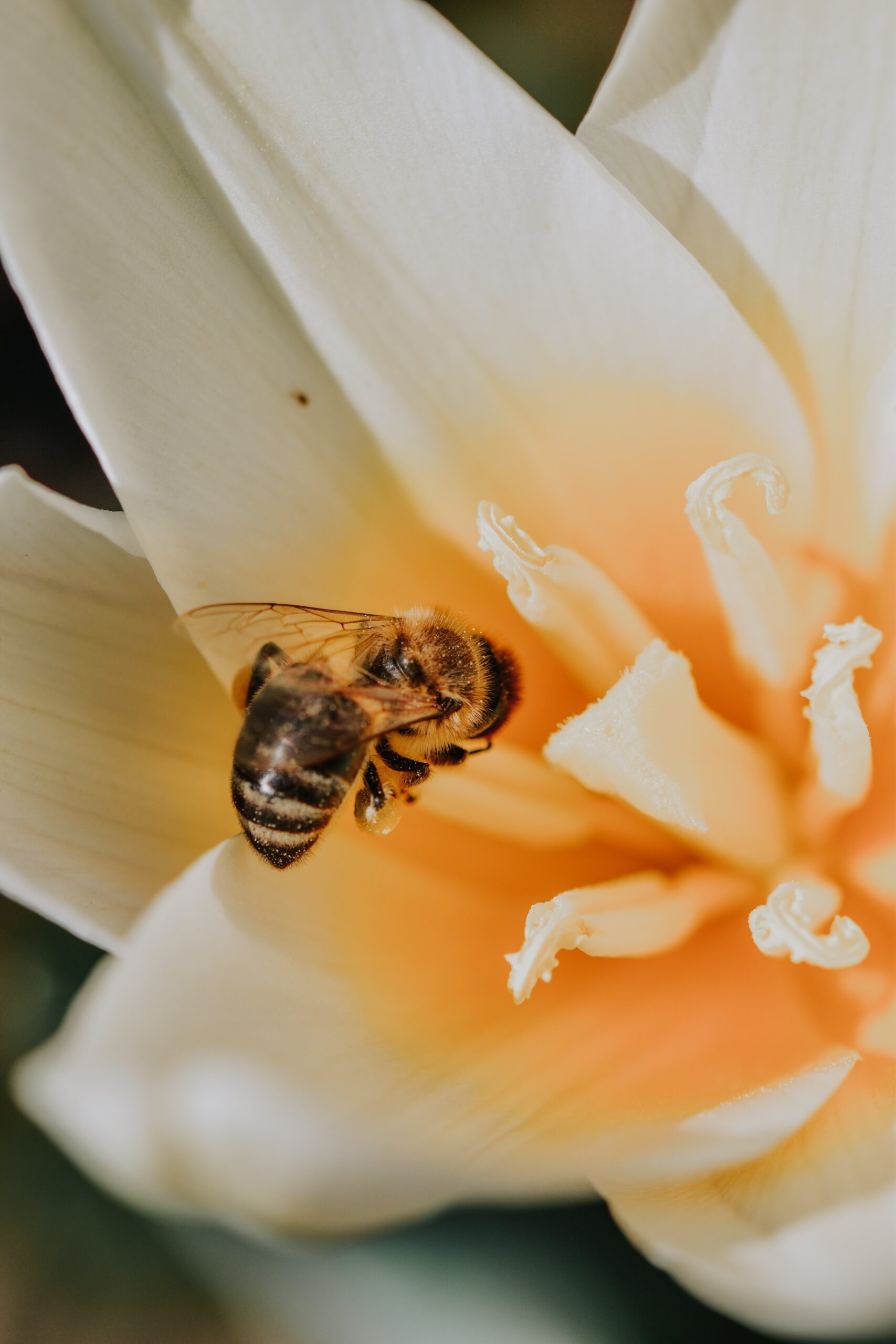The environmental impact of honey
It is no coincidence that bees and honey have been the subject of stories and mythologies, basically as long as humans have existed. Bees, as well as other pollinators, but I guess bees especially because of their honey, have always been a vital part of cultural cuisines, traditions, crafts, our environment, and ecosystems. Beekeeping has been practiced for centuries and played a central role in the development of the systems of agriculture we know today. But you might have heard that the bees are having a tough time right now.
So I want to talk about bees and honey, why the bees are disappearing, and if buying honey has a role to play there. Let’s get into it. Some cool facts about bees.
- A queen bee can have an average lifespan of 1-2 years, but some species can live up to 5 years. Worker bees have a different, and much shorter lifespan of 15-38 days in the summer and 150-200 days in the winter.
- There are around 20,000 different species of wild bees in the world and 8 types of honey bees.
- In the course of a lifetime, a worker bee will produce 1/12th of a teaspoon of honey, it is so much work, and the amount is tiny. To make one pound of honey, the worker bees have to fly 55,000 miles and pollinate over 2 million flowers.

How is that our beesiness?
Bees collect nectar and turn it into honey, Nectar contains sugars, vitamins, salts, oils, and additional nutrients that the bees need to survive. This is the main energy source for bees, but they also require pollen.
Pollen contains protein and fats, and pollination is what happens when bees and other animals move one plant’s pollen to another which enables fertilization, and then we get fruit, and basically, every other food we know and love. Okay.
And pollinators contribute directly to food security. According to bee experts at the Food and Agriculture Organization (FAO) of the United Nations, a third of the world’s food production depends on bees. Bees and other pollinators such as birds and bats, affect 35 percent of the world’s crop production, increasing outputs of 87 of the leading food crops worldwide, plus many plant-derived medicines. There are around 70 crops in the UK that depend on or benefit from bee pollination.
So it is pretty safe to say that we depend on pollination, a lot. Imagine a world without pollinators, our supermarkets would be half empty, they are that important. Bees and other pollinators are declining in abundance in many parts of the world largely due to intensive farming practices, mono-cropping, excessive use of agricultural chemicals, and higher temperatures associated with climate change, affecting not only crop yields but also nutrition. If this trend continues, nutritious crops such as fruits, nuts, and many vegetables will be substituted increasingly by staple crops like rice, corn, and potatoes, eventually resulting in an imbalanced diet.
So it is in everybody’s best interest the increase the number of pollinators in the world, otherwise, we’ll all have to survive on French fries. But we can’t even fry them in oil, because guess what, seed oils need pollination too.
Why do bees make honey?
Honey is not a bi-product (pun intended), bees make honey to eat it. Honey is an incredibly energy-rich food that has plenty of nutrients and health benefits, and naturally, honey is what keeps the bees alive through the winter or periods when they can’t gather pollen from flowers.
Bees also need the energy to regulate the temperature inside the hive, which they do by beating their wings to generate heat, also something made possible by the energy they get from honey. The temperature regulation the bees provide actually also helps turn the collected sugars from nectar into honey.
How is honey made?
Basically, honey is made by reducing the moisture content in nectar, and for the most part that is done after the bees return to the hive. The nectar is stored in the bees’ nectar stomachs, where the bees eventually pump the nectar out of their stomachs for storage. It is, however, not the same as spit or vomit. It doesn’t really make sense to compare the functions and reflexes of insects and mammals, as they serve different purposes, and all in all, aren’t biologically identical. Some people compare honey to vomit, however, that is not quite accurate, and probably a tool to make it seem less appealing, meanwhile, technically not correct. Anyway.
Bees bring back nectar from flowers, they store it inside the honeycomb. Here the nectar gets broken down into simple sugars, and because of the bees’ constant wing batting, it evaporates, leaving behind a thickened substance that we know as honey, which again, the bees need to survive.

Can honey be made sustainably, and ethically?
There are a few different things to consider here, but first of all, I think it is important to note that on some parameters, not all honey is made equal. There is an enormous difference in impact when looking at small-scale hobby farmers compared to industrial beekeeping.
There is also the fact that a lot of industrially produced honey is actually diluted with syrup to make it stretch further because honey is pretty hard to upscale in production, as the bees work as fast as they can with the flowers and plants available. So the honey used in a lot of commercial products is rarely 100% actual honey. There is a great Netflix episode in the series Rotten about this.
Beekeepers of course point towards beekeeping as something that has been practised for centuries, and note that the proper farmers always leave enough honey for the bees to eat. It makes sense that beekeepers are interested in the survival of the bees, but at the same time, it is also common practice, especially for more industrial commercial-grade honey, to take all of the bees’ honey to sell, and replace it with a cheap sugar alternative for the bees to eat, which does not contain the same nutrients and benefits as their honey. But there is an argument to be made that honey from a small beekeeper who leaves honey for the bees to eat is more sustainable, at least when looking at the impact on ecosystems and the health of the bees.
On the other hand, there is the ethical question regarding necessity. Humans don’t need honey to survive, but bees do. This can easily become a tired argument, because, as we have discussed on this platform before, there are many other things that are not “necessary” for human survival but are pretty neat to have anyway, so I won’t dwell too much on that argument, to be honest. Not when there are more important things to consider.
It is basically impossible to produce industry-scale amounts of honey without harming bees, either with smoke, pesticides, and cheap sugar alternatives or simply by letting hives die and then replacing them. All of which also does happen in the industry. And now that we are on ethics, the queen bee’s wings are often snapped off so she can’t fly from the hive.
Bees are in danger
You might have heard, but bees and other pollinators, such as butterflies, bats, and hummingbirds, are increasingly under threat because of pollution from human activities. Bee populations have declined globally during the last decades primarily due to habitat loss, intensive farming practices, changes in weather patterns, and excessive use of agrochemicals, like pesticides. 1 in 6 bee species is regionally extinct and more than 40% are vulnerable to extinction, which is a course for concern, considering how much our global food systems depend on pollination from bees.
Air pollution is also thought to affect bee populations. Research shows that air pollutants interact with scent molecules released by plants which bees use to locate their food. This makes the bees unable to forage and pollinate, effectively. Many bees have to travel more than 3,000 feet from their hive to find their food source, depending only on the scent traces in the air. In the US there are about 4000 native bee species, most of which are solitary bees that are bees that don’t live in hives but rather nest in the ground or cavities. At least 23% of native bees in the US have declined, especially so in areas affected by commodity crop production. Other threats to native bees also include climate-driven landscape changes, like rising sea levels or increased temperatures, and loss of host plants, but, and this is where it gets interesting, they are also threatened by competition and disease from non-native honeybees.

So more bees = fewer bees?
So there are 20,000 different types of bees, but the honey we know probably came from 1 of 8 types of honey bees. What happens often is that the extensive use of honey bees takes over the natural habitat otherwise inhabited by native bees. So multiple species are replaced by 1, typically, and this makes the ecosystem so much more vulnerable to disease.
Basically, we have replaced a natural ecosystem with a mono-culture, and this is just as problematic as when we cut from forests to grow corn or plant lawns. At least it creates a weaker or less functioning ecosystem. And we are shooting ourselves in the foot here because we depend on a variety of pollinators in our food system, yet we play a central role in their decline. Basically, we’re that meme with the guy who put a stick into the wheel of his bike.
We are saving the wrong bees
The bees are dying, but we’re not talking about the 8 types of honey bees here. The population of honeybees is growing exponentially, since the 60s, the number of managed hives has increased by 83%, according to FAO. But honey bees aren’t necessarily the best pollinators. They are what is referred to as “general pollinators” which means that they can pollinate most plants but do so less effectively. It might take thousands of honey bees to pollinate a field of apple trees, but only a couple of hundred wild native bees to do the same. Various types of wild, solitary bees are specifically good at pollinating specific plants, because of evolution they have adapted to the growth and blooming patterns of specific plants making them work ideally in their environment, in contrast to bringing outside guys in to do a worse job. This is why biodiversity is so important and why we can’t “just” replace the dying bee population with honey bees.
As the number of native pollinators, like bees, butterflies, and other insects decline, we have started to use honey bees as the main pollinators for the crops in our food systems. Especially in the US, but increasingly in Europe as well, we are moving honey bees around to pollinate our crops, because it’s more dependable than relying on the few wild pollinators in nature. However, this is terrible for the honey bees. They are exposed to vast amounts of agrochemicals. It is terrible for the wild bees, as the honey bees infect the wild bees with various diseases that the wild bees can’t fight off, so they die, and the honey bees also eat all the food, so there is nothing left for the wild bees, so they die.
The solution we have found to “fix” our very fragile food system has made our food system even more fragile. Because we continuously decreased the population of an animal we absolutely depend on, and cannot replace.
When we say “save the bees” we are not talking about saving the honey bees, it’s not the most effective pollinator to save, at least not when looking at biodiversity and maintaining an ecosystem.
It’s all the other ones. So having a bee hive in your backyard might not be as effective in saving the bees as hoped.
What beeing done about it?
In May 2018, the European Union upheld a partial ban on three insecticides known as neonicotinoids to mitigate the lethal threat they pose to bees.
Ideally, we should also look at how we grow our food in the first place. The number one threat to bees are harsh chemicals used in agriculture and mono-crops, which destroy the habitat for pollinators as well as countless other animals.
- Plant nectar-bearing flowers such as marigolds or sunflowers for decorative purposes on balconies, terraces, and gardens
- If you’re eating honey, avoid it in all processed foods, and buy solely from small local beekeepers
- Set up a pollinator farm, or insect hotel on your balcony, terrace, or garden
- Preserve old meadows, which feature a more diverse array of flowers, and nectar-bearing plants
- Cut grass on meadows only after the nectar-bearing plants have finished blooming
- Avoid using pesticides in your garden, and buy organic products where agrochemicals haven’t been used.
- Eat seasonal, and local produce.
- Support small, organic, farmers, whenever you can, if you can. Because more small-scale farmers means less mono-crop, which means more biodiversity, and that’s the only way to actually save the bees.





